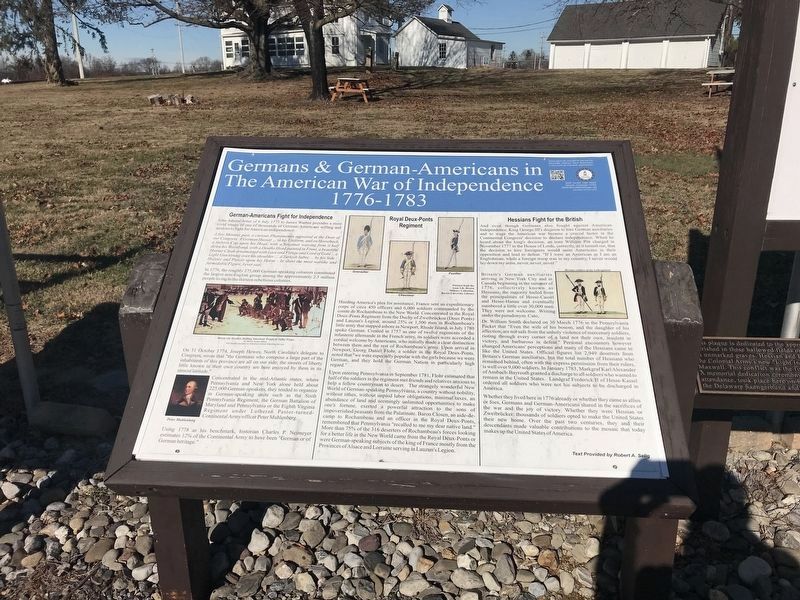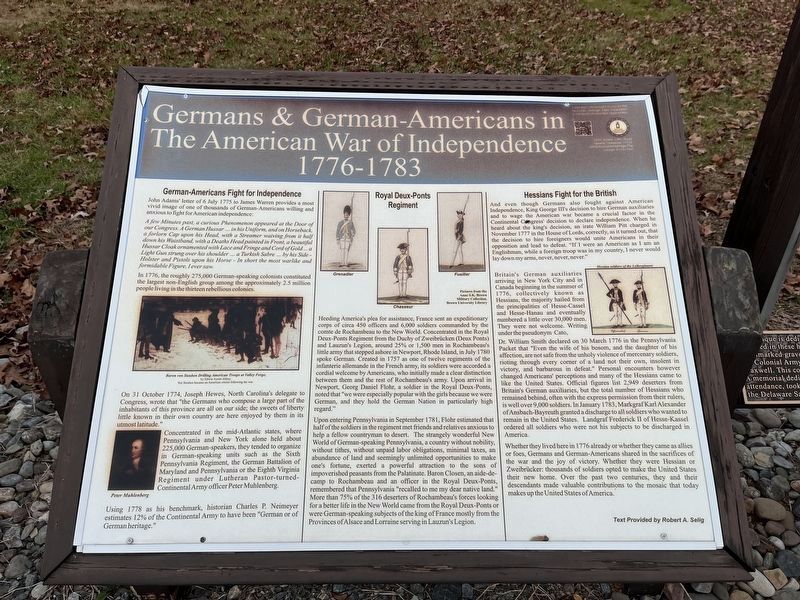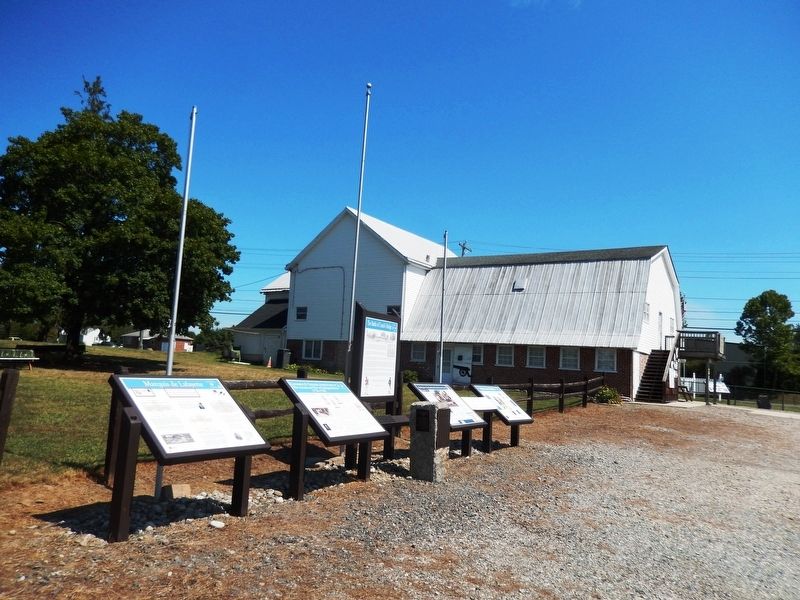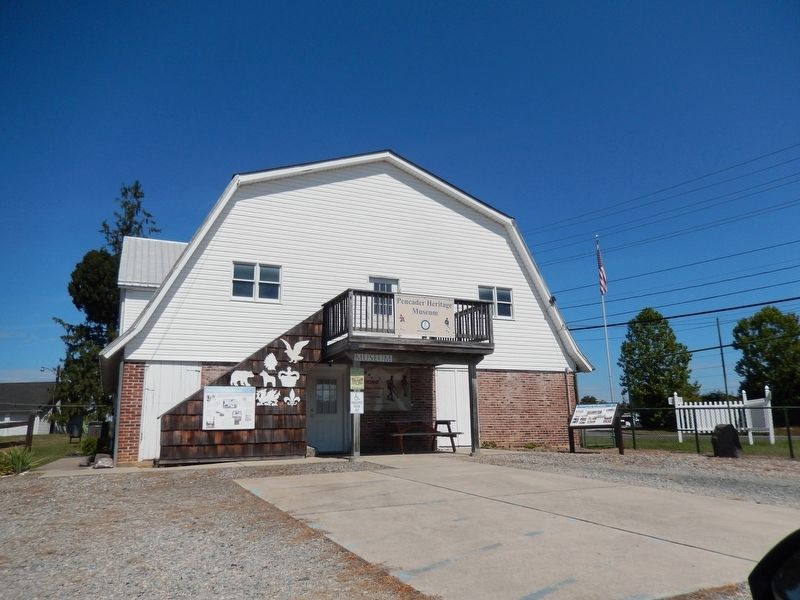Near Newark in New Castle County, Delaware — The American Northeast (Mid-Atlantic)
Germans & German-Americans in The American War of Independence
1776-1783
Inscription.
(left side text)
John Adams’ letter of 6 July 1775 to James Warren provides a most vivid image of one of thousands of German-Americans willing and anxious to fight for American independence:
A few Minutes past, a curious Phenomenon appeared at the Door of our Congress. A German Hussar…in his Uniform and on Horseback, a forlorn Cap upon his head, with a Streamer waiving from it half down his Waistband, with a Deaths Head painted in Front, a beautiful Hussar Cloak ornamented with Lace and Fringe and Cord of Gold…a Light Gun strung over his shoulder…a Turkish Sabre…by his Side-Holster and Pistols upon his Horse-In short the most warlike and formidable Figure, I ever saw.
In 1776, the roughly 275,000 German-speaking colonists constituted the largest non-English group among the approximately 2.5 million people living in the thirteen rebellious colonies.
On 31 October 1774, Joseph Hewes, North Carolina’s delegate to Congress, wrote that “Germans who compose a large pat of the inhabitants of this province are all on our side; the sweets of liberty little known in their own country are here enjoyed by them in its utmost latitude.” Concentrated in the mid-Atlantic states, where Pennsylvania and New York alone held about 225,000 German-speakers, they tended to organize in German-speaking units such as the Sixth Pennsylvania Regiment, the German Battalion of Maryland and Pennsylvania or the Eighth Virginia Regiment under Lutheran Pastor-turned Continental Army officer Peter Muhlenberg.
Using 1778 as his benchmark, historian Charles P. Neimeyer estimates 12% of the Continental Army to have been “German or of German heritage.
(center text)
Heeding America’s plea for assistance, France sent an expeditionary corps of circa 450 officers and 6,000 soldiers commanded by the comte de Rochambeau to the New World. Concentrated in the Royal Deux-Ponts Regiment from the Duchy of Zweibrucken (Deux Ponts) and Lauzun’s Legion, around 25% or 1,500 men in Rochambeau’s little army that stepped ashore in Newport, Rhode Island, in July 1780 spoke German. Created in 1757 as one of twelve regiments of the infanterie allemande in the French Army, its soldiers were accorded a cordial welcome by Americans, who initially made a clear distinction between them and the rest of Rochambeau’s army. Upon arrival in Newport, Georg Daniel Flohr, a soldier in the Royal Deux-Ponts, noted that “we were especially popular with the girls because we were German, and they hold the German Nation in particularly high regard.”
Upon entering Pennsylvania
in September 1781, Flohr estimated that half of the soldiers in the regiment met friends and relatives anxious to help a fellow countryman to desert. The strangely wonderful New World of German-speaking Pennsylvania, a country without nobility, without tithes, without unpaid labor obligations, minimal taxes, an abundance of land and seemingly unlimited opportunities to make one’s fortune, exerted a powerful attraction to the sons of impoverished peasants from the Palatinate. Baron Close, an aide-de-camp to Rochambeau and an officer in the Royal Deux-Ponts, remembered that Pennsylvania “recalled to me my dear native land.” More than 75% of the 316 deserters of Rochambeau’s forces looking for a better in the New World came from the Royal Deux-Ponts or were German-speaking subjects of the king of France mostly from the Provinces of Alsace and Lorraine serving in Lauzun’s Legion.
(right side text)
And even though Germans also fought against American Independence, King George III’s decision to hire German auxiliaries and to wage the American war became a crucial factor in the Continental Congress’ decision to declare independence. When he heard about the king’s decision, an irate William Pitt charged in November 1777 in the House of Lords, correctly, as it turned out, that the decision to hire foreigners would
unite Americans in their opposition and lead to defeat. “If I were an American as I am an Englishman, while a foreign troop was in my country, I never would lay down arms, never, never, never.”
Britain’s German auxiliaries arriving in New York City and in Canada beginning in the summer of 1776, collectively known as Hessians, the majority hailed from the principalities of Hesse-Cassel and Hesse-Hanau and eventually numbered a little over 30,000 men. They were not welcome. Writing under the pseudonym Cato, Dr William Smith declared on 30 March 1776 in the Pennsylvania Packet that “Even the wife of his bosom, and the daughter of his affection, are not safe from the unholy violence of mercenary soldiers, rioting through every corner of a land not their own, insolent in victory, and barbarous in defeat.” Personal encounters however changed American’ perceptions and many of the Hessians came to like the United States. Official figures list 2,949 deserters from Britain’s German auxiliaries, but the total number of Hessians who remained behind, often with the express permission from their rulers, is well over 9,000 soldiers. In January 1783, Markgraf Karl Alexander of Ansbach-Bayreuth granted discharge to all soldiers who wanted to remain in the United States. Landgraf Frederick II of Hesse-Kassel ordered all soldiers who were not his subjects to be discharged in America.
Whether
they lived here in 1776 already or whether they came as allies or foes, Germans and German-Americans shared in the sacrifices of the war and the joy of victory. Whether they were Hessian or Zweibrucker: thousands of soldiers opted to make the United States their new home. Over the past two centuries, they and their descendants made valuable contributions to the mosaic that today makes up the United States of America.
Text Provided by Robert A. Selig
Erected by Pencader Heritage Area Association.
Topics and series. This historical marker is listed in this topic list: War, US Revolutionary. In addition, it is included in the Former U.S. Presidents: #02 John Adams series list.
Location. 39° 38.379′ N, 75° 43.801′ W. Marker is near Newark, Delaware, in New Castle County. Marker is on Sunset Lake Road (Delaware Route 72). The marker is on the grounds of the Pencader Heritage Museum. Touch for map. Marker is at or near this postal address: 2029 Sunset Lake Road, Newark DE 19702, United States of America. Touch for directions.
Other nearby markers. At least 8 other markers are within walking distance of this marker. Hessian Soldiers Memorial (here, next to this marker); French General Comte de Rochambeau and the French Army Memorial (here, next to this marker); The Royal Deux-Ponts Memorial (here, next to this marker); The Battle of Cooch's Bridge (here, next to this marker); Marquis de Lafayette (here, next to this marker); Washington-Rochambeau Revolutionary Route (here, next to this marker); Delaware Militia (here, next to this marker); American Position (approx. 0.2 miles away). Touch for a list and map of all markers in Newark.
Credits. This page was last revised on December 31, 2023. It was originally submitted on September 21, 2019, by Don Morfe of Baltimore, Maryland. This page has been viewed 283 times since then and 25 times this year. Last updated on August 13, 2020, by Carl Gordon Moore Jr. of North East, Maryland. Photos: 1. submitted on January 22, 2022, by Adam Margolis of Mission Viejo, California. 2. submitted on December 31, 2023, by Devry Becker Jones of Washington, District of Columbia. 3, 4. submitted on September 21, 2019, by Don Morfe of Baltimore, Maryland. • Bill Pfingsten was the editor who published this page.



